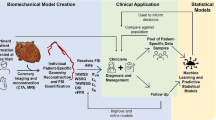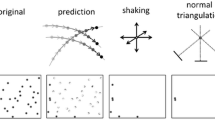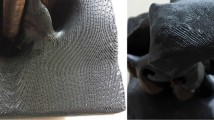Abstract
Topological and metric properties of Voronoi polyhedra (VP) generated by the distal end points of terminal segments in arterial tree models grown by the method of constrained constructive optimization (CCO) are analyzed with the aim to characterize the spatial distribution of their supply sites relative to randomly distributed points as a reference model. The distributions of the number N f of Voronoi cell faces, cell volume V, surface area S, area A of individual cell faces, and asphericity parameter α of the CCO models are all significantly different from the ones of random points, whereas the distributions of V, S, and α are also significantly different among CCO models optimized for minimum intravascular volume and minimum segment length (p < 0.0001). The distributions of N f , V, and S of the CCO models are reasonably well approximated by two-parameter gamma distributions. We study scaling of intravascular blood volume and arterial cross-sectional area with the volume of supplied tissue, the latter being represented by the VP of the respective terminal segments. We observe scaling exponents from 1.20 ± 0.007 to 1.08 ± 0.005 for intravascular blood volume and 0.77 ± 0.01 for arterial cross-sectional area. Setting terminal flows proportional to the associated VP volumes during tree construction yields a relative dispersion of terminal flows of 37% and a coefficient of skewness of 1.12. © 2003 Biomedical Engineering Society.
PAC2003: 8719Uv, 8710+e, 4720Ky, 0260Pn, 0230Oz
Similar content being viewed by others
References
Allen, M. P., and D. J. Tildesley. Computer Simulation of Liquids. Oxford: Oxford University Press, 1987, pp. 54–55.
Arts, T., R. T. I. Kruger, W. VanGerven, J. A. C. Lambregts, and R. S. Reneman. Propagation velocity and reflection of pressure waves in the canine coronary artery. Am. J. Physiol.237:H469–H474, 1979.
Aurenhammer, F., and R. Klein. Voronoi diagrams. In: Handbook of Computational Geometry, edited by J. R. Sack and J. Urrutia. Amsterdam: Elsevier Science B. V., 2000, pp. 201–290.
Barber, C. B., and H. Huhdanpaa. Qhull version 2.6. The Geometry Center, University of Minnesota, Minneapolis, 1998. http://www.geom.umn.edu/locate/qhull.
Barber, C. B., D. P. Dobkin, and H. Huhdanpaa. The quickhull algorithm for convex hulls. ACM Trans. Math. Softw.22:469–483, 1996.
Bassingthwaighte, J. B., R. B. King, and S. A. Roger. Fractal nature of regional myocardial blood flow heterogeneity. Circ. Res.65:578–590, 1989.
Beard, D. A., and J. B. Bassingthwaighte. The fractal nature of myocardial blood flow emerges from a whole-organ model of arterial network. J. Vasc. Res.37:282–296, 2000.
Beard, D. A., and J. B. Bassingthwaighte. Modeling advection and diffusion of oxygen in complex vascular networks. Ann. Biomed. Eng.29:298–310, 2001.
Brown, D. Voronoi diagrams from convex hulls. Inf. Process. Lett.9:223–228, 1979.
Chilian, W. M., S. M. Layne, E. C. Klausner, C. L. Eastham, and M. L. Marcus. Redistribution of coronary microvascular resistance produced by dipyridamole. Am. J. Physiol.256:H383–H390, 1989.
Chilian, W. M.Microvascular pressures and resistances in the left ventricular subepicardium and subendocardium. Circ. Res.69:561–570, 1991.
Dirichlet, G. L.über die Reduction der positiven quadratischen Formen mit drei unbestimmten ganzen Zahlen. J. Reine Angew. Math.40:209–227, 1850.
Fung, Y. C. Biomechanics: Motion, Flow, Stress, and Growth. New York: Springer, 1990, pp. 155–195.
Glenny, R. W., and H. T. Robertson. Fractal properties of pulmonary blood flow: Characterization of spatial heterogeneity. J. Appl. Physiol.69:532–545, 1990.
Glenny, R. W., and H. T. Robertson. A computer simulation of pulmonary perfusion in three dimensions. J. Appl. Physiol.79:357–369, 1995.
Gil Montoro, J. C., and J. L. F. Abascal. The Voronoi polyhedra as tools for structure determination in simple disordered systems. J. Phys. Chem.97:4211–4215, 1993.
Gil Montoro, J. C., F. Bresme, and J. L. F. Abascal. Ionic association in electrolyte solutions: A Voronoi polyhedra analysis. J. Chem. Phys.101:10892–10898, 1994.
Gödde, R., and H. Kurz. Structural and biophysical simulation of angiogenesis and vascular remodeling. Dev. Dyn.220:387–401, 2001.
Hinde, A. L., and R. E. Miles. Monte Carlo estimates of the distributions of the random polygons of the Voronoi tessellation with respect to a Poisson process. J. Stat. Comput. Simul.10:205–223, 1980.
Honda, H.Description of cellular patterns by Dirichlet domains: The two-dimensional case. J. Theor. Biol.72:523–543, 1978.
Hoofd, L., Z. Turek, K. Kubat, B. E. M. Ringnalda, and S. Kazda. Variability of intercapillary distance estimated on histological sections of rat heart. Adv. Exp. Med. Biol.191:239–247, 1985.
Hudlicka, O., A. J. Wright, and A. M. Ziada. Angiogenesis in the heart and skeletal muscle. Can. J. Cardiol.2:120–123, 1986.
Jedlovszky, P.Voronoi polyhedra analysis of the local structure of water from ambient to supercritical conditions. J. Chem. Phys.111:5975–5985, 1999.
Kamiya, A., and T. Togawa. Optimal branching structure of the vascular tree. Bull. Math. Biophys.34:431–438, 1972.
Karch, R., F. Neumann, M. Neumann, and W. Schreiner. A three-dimensional model for arterial tree representation, generated by constrained constructive optimization. Comput. Biol. Med.29:19–38, 1999.
Karch, R., F. Neumann, M. Neumann, and W. Schreiner. Staged growth of optimized arterial model trees. Ann. Biomed. Eng.28:495–511, 2000.
Kassab, G. S., C. A. Rider, N. J. Tang, and Y.-C. B. Fung. Morphometry of pig coronary arterial trees. Am. J. Physiol.265:H350–H365, 1993.
Kassab, G. S., J. Berkley, and Y. C. B. Fung. Analysis of pig's coronary arterial blood flow with detailed anatomical data. Ann. Biomed. Eng.25:204–217, 1997.
King, R. B., L. J. Weissman, and J. B. Bassingthwaighte. Fractal descriptions for spatial statistics. Ann. Biomed. Eng.18:111–121, 1980.
Kumar, S., S. K. Kurtz, J. R. Banavar, and M. G. Sharma. Properties of a three-dimensional Poisson–Voronoi tesselation: A Monte Carlo study. J. Stat. Phys.67:523–551, 1992.
Kumar, S., and S. K. Kurtz. Properties of a two-dimensional Poisson–Voronoi tesselation: A Monte-Carlo study. Mater. Charact.31:55–68, 1993.
Kurz, H., and K. Sandau. Modelling of blood vessel development. Bifurcation pattern and hemodynamics, optimality and allometry. Comments Theor. Biol.4:261–291, 1997.
Levy, S., T. Munzer, M. Phillips, C. Fowler, N. Thurston, D. Krech, S. Wisdom, D. Meyer, and T. Rowley. Geomview version 1.6.1. The Geometry Center, University of Minnesota, Minneapolis, 1998. http://www.geomview.org.
Lipowsky, H. H., and B. W. Zweifach. Methods for the simultaneous measurement of pressure differentials and flows in single unbranched vessels of the microcirculation for rheological studies. Microvasc. Res.14:345–361, 1977.
Meijering, J. L.Interface area, edge length, and number of vertices in crystal aggregates with random nucleation. Philips Res. Rep.8:270–290, 1953.
Murray, C. D.The physiological principle of minimum work. I. The vascular system and the cost of blood volume. Proc. Natl. Acad. Sci. U.S.A.12:207–214, 1926.
Neumann, M., F. J. Vesely, O. Steinhauser, and P. Schuster. Solvation of large dipoles. I. A molecular dynamics study. Mol. Phys.35:841–855, 1978.
Neumann, F., M. Neumann, R. Karch, and W. Schreiner. Visualization of computer-generated arterial model trees. In: Simulation Modelling in Bioengineering, edited by M. Cerrolaza, D. Jugo, and C. A. Brebbia. Southampton: Computational Mechanics, 1996, pp. 259–268.
Okabe, A., B. Boots, K. Sugihara, and S. N. Chiu. Spatial Tessellations: Concepts and Applications of Voronoi Diagrams, Second Edition. Chichester: Wiley, 1999.
Preparata, F. P., and M. I. Shamos. Computational Geometry. An Introduction. New York: Springer, 1985.
Prothero, J. W.Scaling of blood parameters in mammals. Comparative Biochem. Physiol.67A:649–657, 1980.
Qian, H., and J. B. Bassingthwaighte. A class of flow bifurcation models with lognormal distribution and fractal dispersion. J. Theor. Biol.205:261–268, 2000.
Rahman, A. Liquid structure and self-diffusion. J. Chem. Phys.45:2584–2592, 1966.
Ripley, B. D.Test of ‘randomness’ for spatial point patterns. J. R. Statist. Soc. B41:368–374, 1979.
Rosen, R. Optimality Principles in Biology. London: Butterworth, 1967, pp. 40–60.
Ruocco, G., M. Sampoli, and R. Vallauri. Analysis of the network topology in liquid water and hydrogen sulphide by computer simulation. J. Chem. Phys.96:6167–6176, 1992.
Sandau, K., and H. Kurz. Modelling of vascular growth processes: A stochastic biophysical approach to embryonic angiogenesis. J. Microsc.175:205–213, 1994.
Schreiner, W.Computer generation of complex arterial tree models. J. Biomed. Eng.15:148–149, 1993.
Schreiner, W., and P. Buxbaum. Computer-optimization of vascular trees. IEEE Trans. Biomed. Eng.40:482–491, 1993.
Schreiner, W., M. Neumann, F. Neumann, S. M. Roedler, A. End, P. Buxbaum, M. R. Müller, and P. Spieckermann. The branching angles in computer-generated optimized models of arterial trees. J. Gen. Physiol.103:975–989, 1994.
Seiler, C., R. L. Kirkeeide, and K. L. Gould. Basic structure-function relations of the epicardial coronary vascular tree. Circulation85:1987–2003, 1992.
Stoyan, D., and H. Stoyan. Fractals, Random Shapes and Point Fields. Chichester: Wiley, 1994.
Strahler, A. N.Quantitative analysis of watershed geomorphology. Trans. Am. Geophys. Union38:913–920, 1957.
Thompson, D. W. On Growth and Form. Cambridge, MA: Cambridge University Press, 1917.
Van Bavel, E., and J. A. E. Spaan. Branching patterns in the porcine coronary arterial tree. Estimation of flow heterogeneity. Circ. Res.71:1200–1212, 1992.
Van Beek, J. H. G. M., S. A. Roger, and J. B. Bassingthwaighte. Regional myocardial flow heterogeneity explained with fractal networks. Am. J. Physiol.257:H1670–H1680, 1989.
Vaz, M. F., and M. A. Fortes. Grain size distribution: The lognormal and the gamma distribution functions. Scr. Metall.22:35–40, 1988.
Voronoi, G.Nouvelles applications des parametres continus a la theorie des formes quadratiques. J. Reine Angew. Math.134:198–287, 1908.
Wang, C. Y., and J. B. Bassingthwaighte. Capillary supply regions. Math. Biosci.173:103–114, 2001.
West, G. B., J. H. Brown, and B. J. Enquist. A general model for the origin of allometric scaling laws in biology. Science276:122–126, 1997.
Woldenberg, M. J., and K. Horsfield. Relation of branching angles to optimality for four cost principles. J. Theor. Biol.122:187–204, 1986.
Zamir, M.Optimality principles in arterial branching. J. Theor. Biol.62:227–251, 1976.
Zamir, M., J. A. Medeiros, and T. K. Cunningham. Arterial bifurcations in the human retina. J. Gen. Physiol.74:537–548, 1979.
Author information
Authors and Affiliations
Rights and permissions
About this article
Cite this article
Karch, R., Neumann, F., Neumann, M. et al. Voronoi Polyhedra Analysis of Optimized Arterial Tree Models. Annals of Biomedical Engineering 31, 548–563 (2003). https://doi.org/10.1114/1.1566444
Issue Date:
DOI: https://doi.org/10.1114/1.1566444




